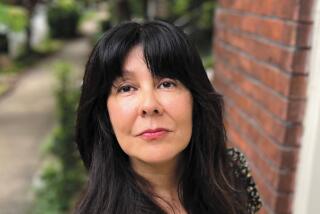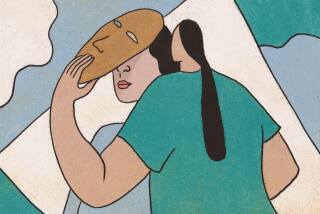Cherríe Moraga’s memoir reconsiders ‘home’ in a post-colonial landscape
“Perhaps my writing has never really been about me,” Cherríe Moraga admits in “Native Country of the Heart,” her bracing new memoir. “Perhaps it was about she all along: she without letters; she fallen off the map of recorded histories; she that is my history and my future with every Mexicana female worker who comes to, or is born into, these lands of ill-manifested destiny.”
As a writer and activist, Moraga has dedicated her career to the literature of queer women of color. In 1981, she co-edited the feminist anthology “This Bridge Called My Back: Writings by Radical Women of Color,” a central text for third-wave feminism. In 1983, she cofounded Kitchen Table: Women of Color Press with Barbara Smith and Audre Lorde.
In “Native Country,” she is most explicitly her mother, Elvira, the unlettered and domineering family matriarch. Moraga plots her own story within the arc of this maternal narrative: Between scenes of Elvira picking cotton as a child in the Imperial Valley, selling cigarettes in 1930s Tijuana, raising her family in San Gabriel and battling Alzheimer’s in old age, we watch Moraga confront her Roman Catholic upbringing, grow to understand herself as “Mexican, mixed-blood, queer, female, almost-Indian” and eventually assume control of Elvira’s well-being.
Both journeys are a struggle, and each is expertly told in Moraga’s lucid prose. But the real purpose of these two paths is to provide the structure for Moraga’s deeper pursuits: how to understand “home” in this mixed-up, post-colonial landscape? What lessons of belonging might a young queer Chicana learn from a mother who cannot write and whose memory decays? How can a person with so few means of record still relate to one’s origins? These questions plague diasporic communities in Los Angeles and beyond. Immigration is always fraught with danger and uncertainty, but “Native Country” offers some solace for those settling anew.
Moraga seeks her answers in the region’s geography as much as in her mother’s patched-together oral stories. She recounts growing up and grappling with her sexuality in the neighborhood of an old Spanish mission and the sites of unmarked Tongva graves; at the same time, a young Elvira flees from Southern California to Tijuana during the enforced “repatriations” of Mexicans and Mexican Americans in the late 1920s and early 1930s, sacrificing an education to earn an income for a family of alcoholic and itinerant men. These histories converge on the San Gabriel family home.
“But that small white house, a house for which I believed I held no nostalgia, a house I had to leave in order to live, a house I marked as the site and source of my rebellion, had been country to my mother,” writes Moraga. She realizes how a place of great conflict for her (initially, Elvira was not accepting of Moraga’s sexuality), and of widespread historical amnesia, can also be the locus of authority and personhood for her mother: “It allowed her permission to know what she knew and to reign madre over all of it.” The whole Moraga clan congregated at their doorstep to eat or pass time or celebrate.
This conflict plays out repeatedly in San Gabriel, to which Moraga returns after her parents move to an assisted living facility. “Are these small plots of lot and land what is left of memory as Mexicans in the United States?” Moraga asks. “Is this how ancestral memory returns to us, indifferent to the generations and geography of borders?” Her old house at first appears empty, but as she goes from room to room and contemplates these questions, she begins to sense the presence of her ancestors. She sees how “spirit relations had come to reside in that small white house and increased in meaning as my mother’s remembered world lessened in importance.”
Perhaps, suggests Moraga, this is how ancestral memory returns: through accumulated years, through a mother’s ritual prayers — regardless of borders. And perhaps small plots are more than they seem: shaped by the late present as well as a distant past. “I swallowed our Mexican Indian herencia in hard gulps of conciencia,” Moraga writes. “It was [Elvira] they missed, she who heard and spoke to them” and she who, despite her slipping mind, despite her illiteracy, despite her religiosity or iron rule, kept the family connected to its origins. (In the above, as elsewhere in “Native Country,” Moraga’s mix of unitalicized English and Spanish adeptly celebrates and reinforces the culturally specific nature of the work.)
Through sections such as these in San Gabriel, grounded in developed settings and revisited in the text, Moraga best addresses the questions she sets out to answer. At other times, she fails to follow her inquiries. Moraga frequently alludes to her native history in the Sonoran Desert: “There is something to be found in those sites where memory calls us. … We return as refugees to that forgotten landscape which we somehow recognize as home.” Later she mentions a “week away in the Sonoran Desert, the site of my ancestral origins,” where she “kept suffering the question of ‘home.’ ” But Moraga never recounts the details of this trip, never shares that “something to be found.” In a memoir so devoted to places and their histories, this decision is surprising; the absence of a story from the Sonoran Desert is a conspicuous missed opportunity.
Thankfully, the same cannot be said of Mexico, her other ancestral land. Moraga recalls a trip with her parents to the country’s capital, where Elvira professes “her longing for the México of her past … she admitted that in 1939, she had not wanted to return to the Anglo world of the U.S.” Elvira’s regret is presaged by the prior day’s visit to a curandero, who cures her chronic hand rash — relieved by the admission of her sorrow as much as a prescribed tincture. On a solo trip to Mexico two summers later, Moraga faces her own relationship with the country: “I was not one of them and I was not gringa, but something/someone other than either.” Her mixed roots (Moraga’s father is white) bring the issue of her membership to the fore. The next morning, she decides to return to the land of her birth, rather than remain in that of her ancestors. “I left to go back to California to be Chicana.” California: that place of her prior struggles, that place with a shorter past, yet a place with the promise of home.
Throughout the final chapters, which focus on Elvira’s decline, Celia, Moraga’s partner, provides the love and wisdom seen so often from the women in “Native Country.” Together, they settle in Northern California, where Moraga served for over 20 years as an artist-in-residence in the department of theater and performance studies at Stanford.
“It came to me that we are as much of a place as we are of a people,” Moraga concludes in her epilogue. For her, Elvira may well have been both.
::
Cherríe Moraga
Farrar, Straus and Giroux, 256 pp., $26
McCoy is a writer from Arizona and the editor of Contra Viento, a journal for art and literature from rangelands. He lives in Los Angeles.
More to Read
Sign up for our Book Club newsletter
Get the latest news, events and more from the Los Angeles Times Book Club, and help us get L.A. reading and talking.
You may occasionally receive promotional content from the Los Angeles Times.






